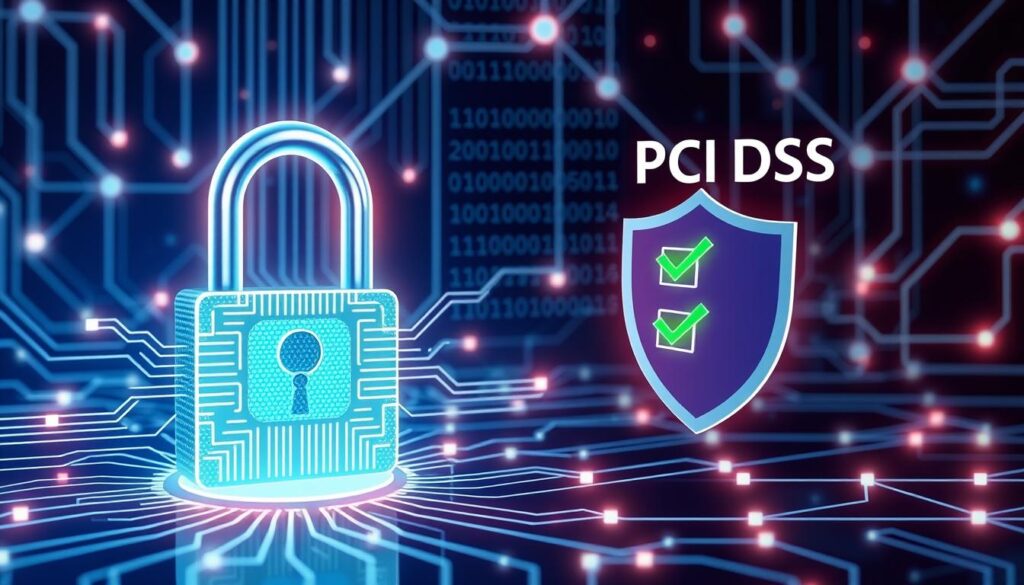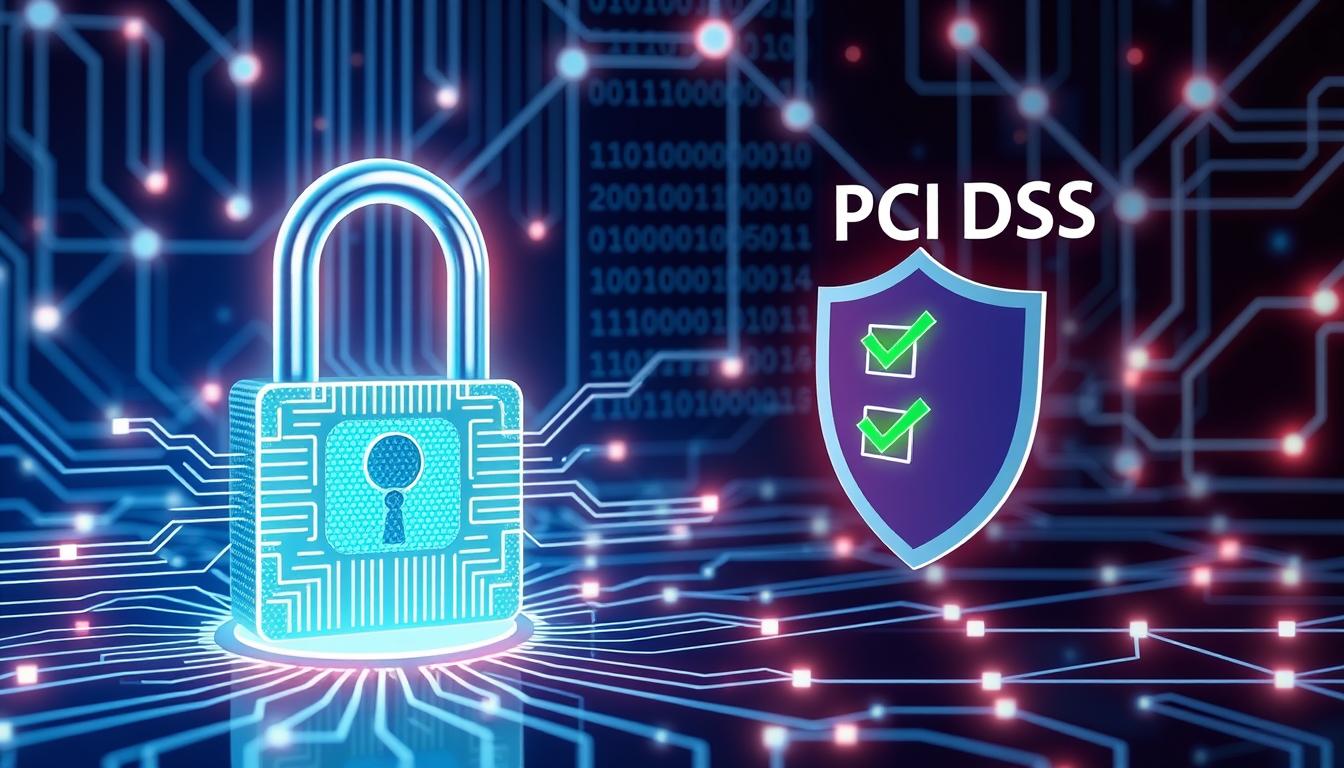Understanding PCI compliance can be tough for businesses. It’s especially hard when you think about the money it costs. This guide will help you understand the costs of PCI compliance. We’ll break down all the expenses you might face.
We’ll look at everything from the first steps to keeping up with compliance. You’ll learn what affects the cost of PCI DSS compliance. This will help you make smart choices and plan your budget better.

Key Takeaways
- PCI compliance is a critical requirement for businesses that process, store, or transmit payment card data.
- The costs of PCI compliance can vary widely, depending on factors such as merchant level, technology investments, and ongoing maintenance.
- Understanding the different components of PCI compliance costs, including assessments, implementation, and validation, is essential for budgeting and planning.
- Businesses can explore cost-saving strategies, such as selecting the right service providers and implementing efficient compliance programs, to optimize their PCI compliance expenses.
- Factoring in hidden costs and unexpected expenses is crucial to avoid financial surprises during the PCI compliance journey.
Understanding PCI Compliance: An Overview
In today’s digital world, keeping payment card data safe is a top priority for businesses. The payment card industry data security standard (PCI DSS) is key to credit card security. It sets a detailed plan to protect consumers and keep the payment system safe.
What is PCI DSS and Why It Matters
PCI DSS is a set of security rules made by the payment card industry. It ensures credit card data is handled and stored safely. All businesses that deal with payment card info must follow these rules. This helps stop data breaches, fraud, and other cyber threats.
Key Components of PCI Compliance
The PCI DSS framework has 12 main parts. These include:
- Maintaining a secure network and systems
- Protecting cardholder data
- Implementing strong access control measures
- Regularly checking and testing network security
- Keeping an information security policy
Who Needs to Be PCI Compliant
Any business that handles credit card data must be PCI compliant. This rule applies to all, big or small, in any industry. This includes online shops, physical stores, banks, and any other place that deals with payment card info.
“Achieving and maintaining PCI compliance is not just a legal requirement – it’s a critical step in safeguarding your business and your customers’ data protection.”
Merchant Levels and Their Impact on Compliance Costs
Knowing the different PCI merchant levels is key to figuring out what your business needs to do to stay compliant. These levels are based on how many transactions you do each year. Each level has its own set of rules and costs.
There are four main levels, from Level 1 for the biggest transaction volumes to Level 4 for the smallest. As you move up the levels, the rules get stricter and the costs go up. This is because you need stronger security and more paperwork.
- Level 1 Merchants: These are businesses that handle over 6 million card transactions a year. They have to do a detailed annual check by a Qualified Security Assessor (QSA) and keep a detailed Report on Compliance (ROC).
- Level 2 Merchants: These are merchants with 1 million to 6 million card transactions a year. They need to do an annual Self-Assessment Questionnaire (SAQ) and might need a QSA for some checks.
- Level 3 Merchants: Businesses with 20,000 to 1 million card transactions a year are Level 3. They have to do an annual SAQ, but the exact needs can change based on their volume and other things.
- Level 4 Merchants: This level is for merchants with less than 20,000 card transactions a year. They still have to follow PCI DSS rules, but it’s less complicated. They might only need a simple SAQ.
Understanding your merchant level and what it means for compliance can help your business plan and budget. This way, you can make sure you’re protecting your customers’ data and staying compliant.
How Much Does It Cost to Be PCI Compliant: Breaking Down the Expenses
Getting PCI compliant is key for businesses that deal with credit card payments. But, it can be pricey. Knowing the different costs helps with planning and budgeting. Let’s look at the main expenses for PCI compliance.
Initial Assessment Costs
The first step is a detailed security check. A Qualified Security Assessor (QSA) looks at your security and finds what’s missing. This initial check can cost between $15,000 to $50,000, based on your business size and complexity.
Implementation Expenses
After the check, you need to fix any security issues. This means spending on PCI compliance costs like firewalls, encryption, and secure payment systems. These implementation expenses can be $20,000 to $100,000 or more, depending on your operations.
Ongoing Maintenance Fees
Keeping up with PCI compliance costs money over time. You’ll need to pay for regular security assessments and updates. These ongoing maintenance fees can be $5,000 to $50,000 a year, based on your business size and complexity.
Businesses need to think about their PCI compliance costs, security assessment needs, and implementation expenses. This helps them plan and budget for PCI compliance. Knowing all the costs helps organizations prepare better for compliance.
| Cost Component | Estimated Range |
|---|---|
| Initial Assessment Costs | $15,000 – $50,000 |
| Implementation Expenses | $20,000 – $100,000+ |
| Ongoing Maintenance Fees | $5,000 – $50,000 per year |
Technology Infrastructure Investment Requirements
To meet PCI compliance, businesses need a strong tech setup. This protects customer data and makes payments safe. Upgrades to network security, payment systems, and hardware are essential.
Implementing a network security solution is key. This includes firewalls and systems to detect/prevent intrusions. These tools keep data safe by controlling who can access it.
Businesses also need to use secure payment systems that follow PCI DSS rules. This might mean updating POS systems, using encryption, and connecting with secure payment gateways.
Lastly, hardware upgrades are needed to support these security steps. Servers, storage, and networking gear must be updated to handle the new security measures.
| Infrastructure Component | PCI Compliance Requirement |
|---|---|
| Network Security | Firewall, Intrusion Detection/Prevention Systems |
| Secure Payment Systems | Upgraded POS Terminals, Encryption, Payment Gateways |
| Hardware Upgrades | Servers, Storage, Networking Equipment |
Building a strong tech foundation is vital for PCI compliance. By focusing on network security, payment systems, and hardware, businesses can safeguard customer data. This helps avoid penalties and data breaches.

Security Tools and Software Expenses
To meet PCI compliance, businesses need strong cybersecurity. This includes essential tools and software. These solutions protect sensitive data but come with costs.
Firewall and Antivirus Solutions
Firewalls and antivirus software are key to a solid cybersecurity plan. They help control network traffic and fight malware. The cost depends on the business’s IT setup.
Encryption Software Costs
Data encryption is vital for PCI compliance. It keeps cardholder info safe. Reliable encryption software is needed, but it can be pricey, especially for big companies.
Vulnerability Scanning Tools
- Regular scans find and fix security issues quickly.
- Investing in good vulnerability management software is crucial. It keeps systems safe from threats.
- The cost of scanning tools depends on the business size, assets, and complexity.
| Security Tool | Average Cost | Key Considerations |
|---|---|---|
| Firewall | $500 – $5,000+ | Varies based on the size of the organization, number of users, and level of complexity |
| Antivirus Software | $30 – $100 per user | Subscription-based pricing, with discounts for larger user licenses |
| Encryption Software | $1,000 – $10,000+ | Dependent on the size of the data environment and the level of encryption required |
| Vulnerability Scanning Tools | $500 – $5,000 per year | Pricing based on the number of assets to be scanned and the frequency of scanning |
Choosing the right cybersecurity software, data encryption, and vulnerability management tools is key. They help keep customer data safe and meet PCI standards. While they cost a lot, the benefits of protecting data are worth it.
Staff Training and Personnel Costs
Having a security-aware team is key to keeping PCI compliance. The cost of training and developing staff is a big part of the PCI compliance budget. These costs cover programs for security awareness, compliance education, and ongoing training.
Security awareness training is a major expense. Companies need to invest in programs that teach employees about security threats and handling sensitive data. Training can be in-person, online, or through interactive simulations.
Organizations also need to budget for compliance education. This training teaches staff about PCI DSS rules, their roles in keeping compliance, and the risks of not following these rules. This helps create a culture of security and reduces the risk of data breaches or fines.
Employee development is another big cost. As technology and security needs change, companies must keep their staff updated. This includes regular training, updates on PCI DSS, and special training for IT and security teams.
By focusing on security awareness, compliance education, and employee development, companies can build a strong defense against data breaches. This ensures their PCI compliance efforts are sustainable in the long term.
“Investing in employee education and training is one of the most effective ways to strengthen an organization’s security posture and maintain PCI compliance.”
Compliance Validation and Certification Fees
Getting and keeping PCI compliance is more than just security steps. It also means going through a detailed validation and certification process. This step is key to make sure your business meets the PCI SSC standards. Knowing the costs helps with budgeting for your PCI compliance work.
QSA Assessment Costs
One big cost is the Qualified Security Assessor (QSA) assessment. QSAs are experts who check your security and documents. Their fees can be from $15,000 to $50,000 or more, based on your business size and complexity.
SAQ Filing Expenses
Businesses also need to file a Self-Assessment Questionnaire (SAQ) every year. This lets you check if you follow PCI DSS rules. While the SAQ is free, getting the info and filing it can cost a few hundred to a few thousand dollars.
ROC Documentation Fees
Big organizations need to do a Report on Compliance (ROC) audit. This audit is done by a QSA and costs from $10,000 to $50,000 or more. It depends on your business size and how complex it is.
Remember, the costs for compliance validation and certification are a big part of PCI compliance spending. Knowing these costs early helps plan and budget for your PCI compliance efforts.
Hidden Costs and Unexpected Expenses
Businesses often face compliance surprises and unforeseen security costs when trying to meet PCI standards. These can affect their budget planning and cause financial stress. It’s important to be aware of these hidden costs.
Specialized security tools and software are a big part of these costs. While the initial cost of firewalls, antivirus, and encryption is expected, the ongoing expenses can add up. This can strain the budget for compliance.
Staff training and management are also often overlooked. Teaching employees about PCI compliance is crucial. However, it requires a lot of time and resources.
- Compliance assessments and audits can also present unforeseen security costs. Businesses may need to fix vulnerabilities or invest more to meet PCI standards.
- Businesses should also be ready for compliance surprises like changes in regulations or unexpected fines. These can disrupt budget planning.
To avoid these costs, businesses need to plan carefully. They should research and prepare for all possible expenses. Having a contingency fund is also important. This way, they can navigate the PCI compliance process smoothly and financially.

“Effective PCI compliance requires a holistic understanding of the potential costs, both expected and unexpected. Businesses that can anticipate and plan for these hidden expenses will be better positioned for long-term success.”
| Cost Category | Examples of Hidden Expenses |
|---|---|
| Security Infrastructure | Ongoing maintenance and upgrades for firewalls, antivirus, and encryption tools |
| Personnel | Extensive staff training and compliance management |
| Compliance Validation | Unexpected fines, penalties, and additional assessment costs |
| Regulatory Changes | Adapting to evolving PCI DSS requirements and industry standards |
Cost-Saving Strategies for PCI Compliance
Getting PCI compliance can cost a lot for businesses. But, with smart strategies, you can cut costs and keep your security strong. The trick is to pick the right service providers and set up effective compliance programs.
Selecting the Right Service Providers
Choosing the right service providers for PCI compliance is key to saving money. Look at what vendors offer, their prices, and their expertise. Go for those who focus on PCI compliance. They usually have better and cheaper solutions.
Implementing Efficient Compliance Programs
Businesses can also save by using in-house compliance programs. This means automating tasks, using technology, and training employees well. Doing this helps you reduce compliance cost reduction and keep efficient security measures without needing to outsource a lot.
FAQ
What is PCI DSS and why does it matter?
PCI DSS stands for Payment Card Industry Data Security Standard. It’s a set of rules to keep payment card info safe. Businesses that handle credit or debit card data must follow these standards. This protects customers and prevents data breaches.
What are the key components of PCI compliance?
PCI compliance includes several key areas. These are securing networks and systems, protecting cardholder data, and managing vulnerabilities. It also involves strong access controls, regular network monitoring, and a solid information security policy.
Who needs to be PCI compliant?
Any business that deals with credit or debit card payments must be PCI compliant. This includes merchants, service providers, and any group handling payment card data.
How do the different PCI merchant levels impact compliance costs?
PCI merchant levels are based on transaction volume. Level 1 has the highest volume, and Level 4 the lowest. Compliance costs vary, with Level 1 merchants facing higher expenses for assessments and maintenance.
What are the initial assessment costs for PCI compliance?
PCI compliance initial costs vary. Self-assessments can cost a few hundred dollars, while on-site audits by a QSA can cost thousands. Costs depend on the merchant level, business complexity, and assessment scope.
What kind of implementation expenses are involved in becoming PCI compliant?
Implementation costs include hardware and software upgrades, network security, and secure payment systems. Costs vary based on the business’s current setup and merchant level requirements.
What are the ongoing maintenance fees for PCI compliance?
Ongoing fees include annual assessments, vulnerability scanning, and staff training. Costs range from a few hundred to tens of thousands of dollars, depending on the business size and level.
What technology investments are required for PCI compliance?
Businesses need to invest in security technologies like firewalls, antivirus, and encryption. The needed technology varies by business size, industry, and payment environment.
What are the costs associated with security tools and software for PCI compliance?
Costs for security tools and software include firewalls, antivirus, and encryption. Prices vary by requirement and business size, from hundreds to thousands of dollars.
How much do staff training and personnel costs contribute to PCI compliance?
Staff training and development are key for PCI compliance. Costs include training materials, program delivery, and employee time. These costs are essential for security awareness and compliance education.
What are the compliance validation and certification fees for PCI compliance?
Validation and certification processes include QSA assessments and SAQ filing. Fees range from a few hundred to tens of thousands of dollars, based on merchant level and business complexity.
What are some hidden costs and unexpected expenses associated with PCI compliance?
Hidden costs include additional security measures, technology upgrades, legal fees, and data breach remediation. It’s important to budget for these surprises when planning for PCI compliance.
What cost-saving strategies are available for PCI compliance?
Cost-saving strategies include choosing the right service providers and implementing efficient programs. Businesses can also leverage shared resources and outsource tasks. This optimizes expenses while maintaining security.



